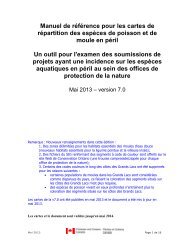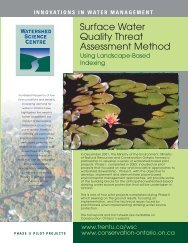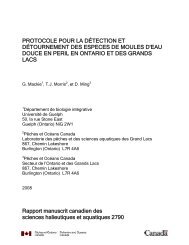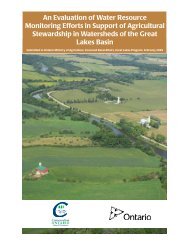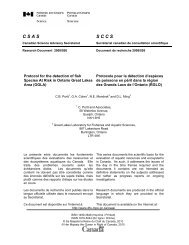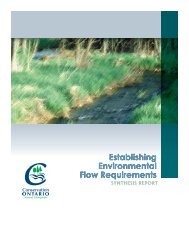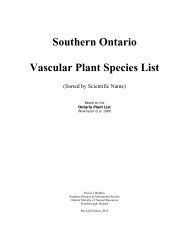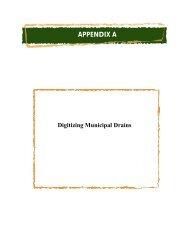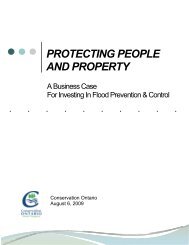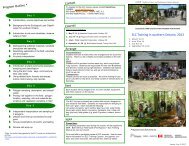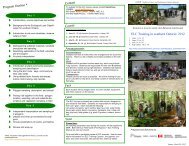Southern Ontario Vascular Plant Species List - Conservation Ontario
Southern Ontario Vascular Plant Species List - Conservation Ontario
Southern Ontario Vascular Plant Species List - Conservation Ontario
You also want an ePaper? Increase the reach of your titles
YUMPU automatically turns print PDFs into web optimized ePapers that Google loves.
S5 - Indicates that a species is widespread in <strong>Ontario</strong>. It is demonstrably secure<br />
in the province<br />
? - A question mark following the rank indicates that there is some uncertainty<br />
with the classification due to insufficient information.<br />
These provincial ranks may further be modified.<br />
S2S3 - Indicates that an element is rare, but insufficient information exists to<br />
accurately assign a single rank<br />
SNR - Unranked — conservation status Not Ranked<br />
SNA - Not Applicable – a conservation status rank is not applicable because<br />
the species is not a suitable target for conservation activities<br />
SX -<br />
SU -<br />
Indicates that an element is extirpated from the province<br />
Indicates that the status is uncertain due to insufficient information<br />
An additional rank not used by the NHIC.<br />
SHY - Indicates that the species is of a HYbrid origin<br />
(This rank is not used by the NHIC, but is included in this listing to<br />
identify plant forms that are variable and are the result of<br />
cross breeding)<br />
<strong>Plant</strong> Form Codes<br />
This column describes the general growth form of a plant species. Is it a forb, shrub or<br />
tree?<br />
Non vascular plants such as moss, liverwort, hornwort, algae and lichen have general<br />
placeholder codes which are included in this listing. In the case of some rock barrens,<br />
moss and lichen species are the dominate plant forms, so it is necessary to record a<br />
percent cover for these non-vascular plant groups. If your organization has someone who<br />
has expertise with non vascular plants or lichens, then identify them down to the genus or<br />
species level whenever possible. Generally, most organizations estimate just one percent<br />
cover value for all of the moss species combined together.<br />
The following is a listing of the abbreviations used in the table along with a brief<br />
explanation for each code.<br />
AL Algae colonial filamentous algal species found in<br />
freshwater aquatic habitats<br />
FE Fern non-flowering, vascular plant, reproducing by spores -<br />
Pteridophytes. Including the fern allies such as horsetail,<br />
viii



